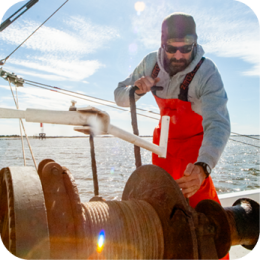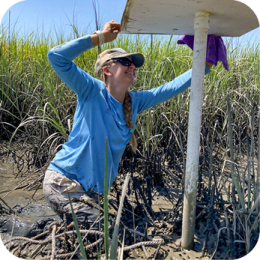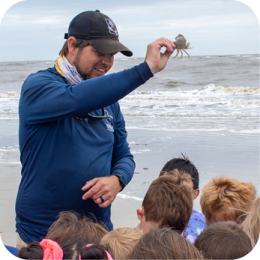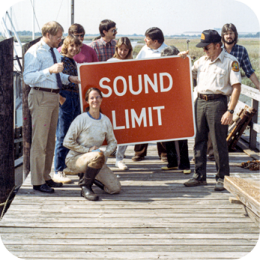This serves as notification from the Coastal Marshlands Protection Committee and the Georgia Department of Natural Resources of a request from the Union Carbide Corporation – Woodbine Facility for a Coastal Marshlands Protection Act (CMPA) permit under Official Code of Georgia (O.C.G.A.) 12-5-280 et seq., to construct a bank stabilization project at Todd Creek, Camden County, Georgia.
The Union Carbide – Woodbine Facility includes a 22-acre Resource Conservation and Recovery Act, Subtitle C permitted landfill. There is an approximately 8-acre buffer north of the landfill that separates the contaminated area from Todd Creek, a tidally influenced tributary of the Satilla River. Currently, the creek is causing severe erosion of the shoreline adjacent to the Union Carbide property, with an erosion rate of more than 8ft. in some places. In some areas of the shoreline there are regulatory markers and sampling wells which are in danger of being compromised if the erosion continues.
The proposed project will consist of constructing a rip rap bank stabilization project with launchable stone toe protection. The Applicant has divided the shoreline into four erosion control measurement (ECM) transects. The proposed bank stabilization project construction will occur on ECM-1 and ECM-4.
Both project sites will be graded to a 2:1 slope up to a 15ft. wide level terrace from which work will be performed. The terraces will be constructed above Mean Higher High Water (2.97ft. NAVD88). The graded slopes will be covered with non-woven geotextile filter fabric overlain by an 8in. think layer of bedding stone (GDOT Type 467 stone). The bedding stone will extend from -5ft. NAVD88 up the slope to an elevation of 11ft. NAVD88. The stone toe protection will be installed on top of the bedding stone and will be made up of GDOT Type 3 rip rap. The stone toe protection layer will extend from an elevation of -5ft. NAVD88 to 1ft. NAVD88 and will be placed at a volume to allow for the stone to self-launch and fill in any scour holes that may occur over time. Stone keys will be installed on both ends of ECM-1 and ECM-4. The keys will angle 30-45 degrees up slope from the toe protection layer. The stone keys will consist of Type 3 rip rap installed in an excavated embankment trench lined with non-woven geotextile fabric and bedding stone. Finally, a 1.5ft. layer of GDOT Type 3 rip rap will be installed from the top of the toe protection (1ft. NAVD88) to a final elevation of 11ft. NAVD88.
ECM-1 is 540ft. long and will have approximately 526cy. of material removed during bank regrading. Construction of the bank stabilization project will involve placing 1,006.1cy. of rock fill and 591.6cy. of earthen fill. Total impacts for ECM-1 within coastal marshlands will be approximately 1,597.7cy.
ECM-4 is 465ft. long and will have approximately 613cy. of material removed during bank regrading. Construction of the bank stabilization will involve placing 623.3cy. of rock fill and 18.7cy. of earthen fill. Total impacts for ECM-4 within coastal marshlands will be approximately 642cy. Total impacts for the proposed bank stabilization projects within coastal marshlands will be 2,239.7cy.
The upland component consists of the 50ft. marshlands buffer associated with each ECM and a stockpile disposal area. The stockpile disposal area, located landward of the marshlands buffer, will be where the soils removed from the shoreline grading will be placed. Trees removed from the shoreline will be chipped and used to berm the outer edges of the stockpile area. The stockpile area is approximately 103,624sq.ft. The 50ft. marshlands buffer for ECM-1 will include 28,768sq.ft. of the bank stabilization project and the temporary impacts associated with construction. The 50ft. marshlands buffer for ECM-4 will include 22,974sq.ft. of the bank stabilization project and temporary impacts associated with construction.
It is the responsibility of the applicant to demonstrate that the project is not contrary to the public interest and that no feasible alternative sites exist. Impacts to coastal marshlands must be minimal in size. In passing upon the application for permit, the Coastal Marshlands Protection Committee shall consider the public interest: (1) Whether or not unreasonably harmful obstruction to or alteration of the natural flow of navigational water within the affected area will arise as a result of the proposal; (2) Whether or not unreasonably harmful or increased erosion, shoaling of channels, or stagnant areas of water will be created; and (3) Whether or not the granting of a permit and the completion of the applicants proposal will unreasonably interfere with the conservation of fish, shrimp, oysters, crabs, clams, or other marine life, wildlife, or other resources, including but not limited to water and oxygen supply.
A detailed public notice with drawings has been distributed and is available by visiting the Department of Natural Resources website: CoastalGaDNR.org under “Marsh & Shore Permits”
Please provide this office with substantive, site-specific comments as to why the proposed work should or should not proceed. Comments and questions concerning this proposed project should be submitted in writing and be submitted by the close of business on April 13, 2020 to Paul Tobler, Department of Natural Resources, One Conservation Way, Brunswick, Georgia 31520.
Click here for the Application.
Click here for the Project Description.







